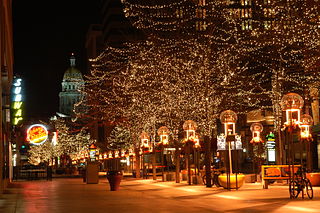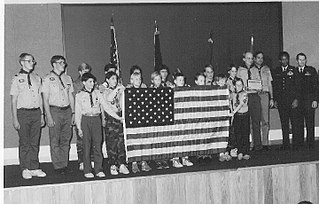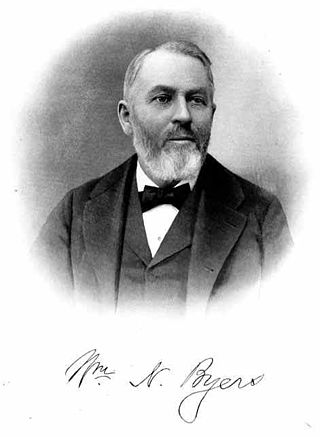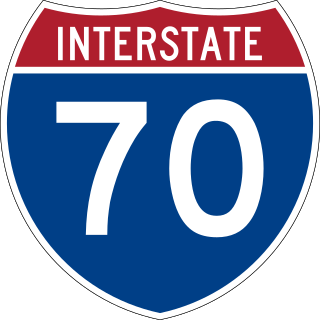
The Seal of the City and County of Denver, also known as The Seal of Denver or The Denver Corporate Seal, is the official seal of the government of Denver, Colorado, USA.

The Seal of the City and County of Denver, also known as The Seal of Denver or The Denver Corporate Seal, is the official seal of the government of Denver, Colorado, USA.
The corporate seal of the City and County of Denver (shown right) was designed by Denver artist Henry Read in 1901. The circular design features an American eagle, reminding us that Denver is a free, American city. The key symbolizes Denver as the key to the Rocky Mountains, and represents the warmth and hospitality extended by Denver citizens to visitors. The capitol dome is included in the seal, as Denver is the capital of the state of Colorado.
The Omaha and Grant Smelter smokestack that were depicted in the seal design was built in 1883, on the east bank of the Platte River. The tall smokestack, built in 1892, was for years the world's tallest structure. It was demolished on February 26, 1950, to clear land for the today's Denver Coliseum. Denver's view of the front range of the Rocky Mountains was shown as a background, with the rays of the setting sun lighting the sky.

Colorado is a state in the Western United States. It is one of the Mountain states, sharing the Four Corners region with Arizona, New Mexico, and Utah. It is also bordered by Wyoming to the north, Nebraska to the northeast, Kansas to the east, and Oklahoma to the southeast. Colorado is noted for its landscape of mountains, forests, high plains, mesas, canyons, plateaus, rivers, and desert lands. It encompasses most of the Southern Rocky Mountains, as well as the northeastern portion of the Colorado Plateau and the western edge of the Great Plains. Colorado is the eighth most extensive and 21st most populous U.S. state. The United States Census Bureau estimated the population of Colorado at 5,877,610 as of July 1, 2023, a 1.80% increase since the 2020 United States census.

Denver is a consolidated city and county, the capital, and most populous city of the U.S. state of Colorado. With a population of 715,522 as of the 2020 census, a 19.22% increase since 2010, it is the 19th-most populous city in the United States and the fifth most populous state capital. Denver is the principal city of the Denver–Aurora–Lakewood metropolitan statistical area, the most populous metropolitan area in Colorado as well as the economic and cultural center of the broader Front Range Urban Corridor, home to more than 5 million people.

Golden is a home rule city that is the county seat of Jefferson County, Colorado, United States. The city population was 20,399 at the 2020 United States Census. Golden lies along Clear Creek at the base of the Front Range of the Rocky Mountains. Founded during the Pike's Peak Gold Rush on June 16, 1859, the mining camp was originally named Golden City in honor of Thomas L. Golden. Golden City served as the capital of the provisional Territory of Jefferson from 1860 to 1861, and capital of the official Territory of Colorado from 1862 to 1867. In 1867, the territorial capital was moved about 12 miles (19 km) east to Denver City. Golden is now a part of the Denver–Aurora–Lakewood, CO Metropolitan Statistical Area and the Front Range Urban Corridor.

Jefferson County is a county located in the U.S. state of Colorado. As of the 2020 census, the population was 582,910, making it the fourth-most populous county in Colorado. The county seat is Golden, and the most populous city is Lakewood.

Scouting in Colorado has a long history, from the 1910s to the present day.

The City of Commerce City is a home rule municipality located in Adams County, Colorado, United States. The city population was 62,418 at the 2020 United States Census, a 35.95% increase since the 2010 United States Census. Commerce City is the 18th most populous municipality in Colorado. Commerce City is located north of Denver and is a part of the Denver–Aurora–Lakewood, CO Metropolitan Statistical Area and the Front Range Urban Corridor. Dick's Sporting Goods Park, a premier soccer stadium facility in Commerce City, hosts the Colorado Rapids of Major League Soccer.

The flag of the U.S. state of Colorado was officially adopted on June 5, 1911. The flag, designed by Andrew Carlisle Carson, consists of a fess design of three horizontal stripes of equal width, with the top and bottom stripes colored blue, and the middle stripe colored white. A circular red "C", filled with a golden disk, sits atop the stripes. All aspects of the flag contain symbolism related to the state, as the blue is meant to represent the sky, the gold the abundant sunshine the state receives, the white the snowcapped Rocky Mountains, and the red the "ruddy" earth. The gold and white portions of the flag also represent the state's gold and silver mining industries, respectively.

The Rocky Mountain College of Art + Design (RMCAD) is a private for-profit art school in Lakewood, Colorado. The college was founded in 1963 by Philip J. Steele, an artist and teacher.

The Denver Civic Center is a civic center area that includes two parks surrounded by government and cultural buildings and spaces. Civic Center is located in central Denver, Colorado, on the south side of Downtown Denver. Much of the area is a historic district which was listed on the National Register of Historic Places in 1974. A somewhat smaller area was designated a U.S. National Historic Landmark in 2012 as one of the nation's finest examples of the City Beautiful movement of civic design. Denver Civic Center lies partially within the north end of an official Denver neighborhood also named Civic Center. It includes the Colorado State Capitol building, in the west end of Denver's official Capitol Hill neighborhood, and it includes a few buildings in the south end of Denver's Central Business District.

William Newton Byers was a founding figure of Omaha, Nebraska, serving as the first deputy surveyor of the Nebraska Territory, on the first Omaha City Council, and as a member of the first Nebraska Territorial Legislature.

The geography of the U.S. State of Colorado is diverse, encompassing both rugged mountainous terrain, vast plains, desert lands, desert canyons, and mesas. Colorado is a landlocked U.S. state. In 1861, the United States Congress defined the boundaries of the new Territory of Colorado exclusively by lines of latitude and longitude, stretching from 37°N to 41°N latitude, and from 102°02'48"W to 109°02'48"W longitude. Starting in 1868, official surveys demarcated the boundaries, deviating from the parallels and meridians in several places. Later surveys attempted to correct some of these mistakes but in 1925 the U.S. Supreme Court affirmed that the earlier demarcation was the official boundary. The borders of Colorado are now officially defined by 697 boundary markers connected by straight boundary lines. Colorado, Wyoming, and Utah are the only states that have their borders defined solely by straight boundary lines with no natural features. The southwest corner of Colorado is the Four Corners Monument at 36°59'56"N, 109°2'43"W. This is the only place in the United States where four states meet: Colorado, New Mexico, Arizona, and Utah.
The History of Denver details the history of the City and County of Denver, Colorado, the United States from its founding in 1858 to modern-day. Ever since the gold rush, Denver has been Colorado’s gateway and major metropolis. With its location at the intersection of the plains and the mountains, its people and institutions have tied together the sections of the state and served as a point of contact between Colorado and the wider world. As the state’s political capital and largest city, Denver has been the natural center for decision-making. New programs and ideas have typically spread outward through the public agencies and private organizations that have Denver headquarters.

Interstate 70 (I-70) is a transcontinental Interstate Highway in the United States, stretching from Cove Fort, Utah, to Baltimore, Maryland. In Colorado, the highway traverses an east–west route across the center of the state. In western Colorado, the highway connects the metropolitan areas of Grand Junction and Denver via a route through the Rocky Mountains. In eastern Colorado, the highway crosses the Great Plains, connecting Denver with metropolitan areas in Kansas and Missouri. Bicycles and other non-motorized vehicles, normally prohibited on Interstate Highways, are allowed on those stretches of I-70 in the Rockies where no other through route exists.

The Lariat Loop National Scenic and Historic Byway is a National Scenic Byway and a Colorado Scenic and Historic Byway located in Jefferson County, Colorado, USA. The byway is a 40-mile (64 km) loop in the Front Range foothills west of Denver through Golden, Lookout Mountain Park, Genesee Park, Evergreen, Morrison, Red Rocks Park, and Dinosaur Ridge. The Lariat Loop connects to the Mount Blue Sky Scenic Byway at Bergen Park.

Riverside Cemetery, established in 1876, is Denver, Colorado's oldest operating cemetery. More than 67,000 people are buried there, including 1,000 veterans.

This is an alphabetical list of articles related to the U.S. State of Colorado.

The following outline is provided as an overview of and topical guide to the U.S. state of Colorado:

The Central Corridor is a rail line operated by the Union Pacific Railroad from near Winnemucca, Nevada to Denver, Colorado in the western United States. The line was created after the merger with the Southern Pacific Transportation Company by combining portions of lines built by former competitors. No portion of the line was originally built by the Union Pacific; in fact, some portions were built specifically to compete with the Union Pacific's Overland Route. The line is known for significant feats of engineering while crossing the Wasatch Mountains of Utah and the Rocky Mountains of Colorado. The line features numerous tunnels; the longest and highest of these is the Moffat Tunnel.

This is a bibliography of the U.S. State of Colorado.
The following is a timeline of the history of the city of Denver, Colorado, United States, from its founding in 1858 to the present.